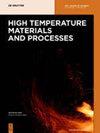Preparation of CaO–SiO2–Al2O3 inorganic fibers from melting-separated red mud
IF 1.5
4区 材料科学
Q4 MATERIALS SCIENCE, MULTIDISCIPLINARY
引用次数: 1
Abstract
Abstract To investigate the feasibility of preparing CaO–SiO2–Al2O3 inorganic fibers with melting-separated red mud, the properties of the melting-separated red mud were analyzed by X-ray fluorescence, X-ray diffraction, and differential thermal-thermogravimetric analyses. The composition of the melting-separated red mud satisfied the requirements for the composition of inorganic fibers. During the melting of the melting-separated red mud, tetrahedral skeleton fracture reactions occurred at 1,234°C, anionic group reverse binding occurred at 1,250°C, and there was no other obvious reaction peak during the whole melting process, which lasted for 51 min. The minimum suitable fiber forming temperature of the melting-separated red mud melt was 1,433°C, which was 83°C greater than its crystallization temperature, 1,350°C. Within this temperature range, the activation energy of particle movement in the melt was 1008.65 kJ·mol−1, and the melt exhibited good fluidity. Considering the temperature distribution corresponding to the melting properties of the melting-separated red mud, CaO–SiO2–Al2O3 inorganic fibers could be prepared when the melting-separated red mud was subjected to component reconstruction by increasing the silicon content, reducing the aluminum content, and adding a moderate amount of calcium. Quartz sand and light burnt dolomite were used as modifying agents and inorganic fibers were prepared under laboratory conditions. The fibers prepared from the modified melting-separated red mud by adding different amounts of melting-separated red mud had smooth surfaces and were arranged in a crossed manner at the macroscopic level. Their color was grayish-white, and small quantities of slag balls were doped inside the fibers. With an increase in the amount of melting-separated red mud from 50 to 100%, the average fiber diameter increased from 5.5 to 8.0 μm, and their slag ball content increased from 2.9 to 6.0%. Overall, under laboratory conditions, when the amount of melting-separated red mud added was 50%, dolomite was 22.5% and quartz sand was 27.5%, the performance of the fiber was the best.熔融分离赤泥制备CaO-SiO2-Al2O3无机纤维
摘要为了研究用熔融分离赤泥制备CaO–SiO2–Al2O3无机纤维的可行性,通过X射线荧光、X射线衍射和差热热重分析对熔融分离赤泥的性能进行了分析。熔融分离的赤泥的组成满足无机纤维组成的要求。熔融分离的赤泥在熔融过程中,1234°C发生四面体骨架断裂反应,1250°C发生阴离子基团反向结合,整个熔融过程中没有其他明显的反应峰,持续51 min。熔融分离的赤泥熔体的最低适宜纤维形成温度为1433°C,比其结晶温度1350°C高83°C。在该温度范围内,熔体中颗粒运动的活化能为1008.65 kJ·mol−1,熔体具有良好的流动性。考虑到与熔融分离赤泥的熔融特性相对应的温度分布,当通过增加硅含量、降低铝含量和添加适量钙对熔融分离赤泥进行组分重构时,可以制备CaO–SiO2–Al2O3无机纤维。以石英砂和轻烧白云石为改性剂,在实验室条件下制备了无机纤维。通过添加不同量的熔融分离的赤泥,由改性的熔融分离赤泥制备的纤维具有光滑的表面,并且在宏观水平上以交叉的方式排列。它们的颜色为灰白色,纤维内部掺杂了少量矿渣球。随着熔融分离赤泥用量从50%增加到100%,纤维的平均直径从5.5μm增加到8.0μm,其渣球含量从2.9%增加到6.0%。总体而言,在实验室条件下,当熔融分离赤泥的添加量为50%、白云石为22.5%、石英砂为27.5%时,纤维的性能最好。
本文章由计算机程序翻译,如有差异,请以英文原文为准。
求助全文
约1分钟内获得全文
求助全文
来源期刊

High Temperature Materials and Processes
工程技术-材料科学:综合
CiteScore
2.50
自引率
0.00%
发文量
42
审稿时长
3.9 months
期刊介绍:
High Temperature Materials and Processes offers an international publication forum for new ideas, insights and results related to high-temperature materials and processes in science and technology. The journal publishes original research papers and short communications addressing topics at the forefront of high-temperature materials research including processing of various materials at high temperatures. Occasionally, reviews of a specific topic are included. The journal also publishes special issues featuring ongoing research programs as well as symposia of high-temperature materials and processes, and other related research activities.
Emphasis is placed on the multi-disciplinary nature of high-temperature materials and processes for various materials in a variety of states. Such a nature of the journal will help readers who wish to become acquainted with related subjects by obtaining information of various aspects of high-temperature materials research. The increasing spread of information on these subjects will also help to shed light on relevant topics of high-temperature materials and processes outside of readers’ own core specialties.
 求助内容:
求助内容: 应助结果提醒方式:
应助结果提醒方式:


